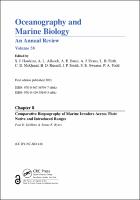Chapter 8 Comparative Biogeography of Marine Invaders Across Their Native and Introduced Ranges
Proposal review
Author(s)
Gribben, Paul E.
Byers, James E.
Language
English[eng]Abstract
Biological invasions continue to exert extensive environmental and economic impacts. Understanding why some introduced species become invasive is critical to their management. Determining the mechanisms underpinning invasion success has focussed on aspects of the ecology and physiology of the species in the introduced range. Through the application of biogeographic approaches, however, a growing body of research highlights insights that stem from studying invasion success as a biogeographic issue. In particular, a comparison of both biogeographic regions (i.e., the native and invasive ranges) allows exclusive insight into seven different major biogeographic hypotheses that we identified to explain invader success. These include the enemy release hypothesis, niche shifts, trait differences, the evolution of invasiveness, native allies, environmental matching, and genetic diversity. All imply a difference or gradient between the ranges that may mechanistically explain an invader’s differential performance. This review summarises the support for these seven different theories underpinning the biogeography of marine invasions, and also provides case studies for different theories addressing the comparative biogeography of marine invasions. Additionally, we catalogue the geographic regions of the invasive species used in biogeographic comparisons and the diversity of species, habitats and climate zones examined. Finally, we highlight critical knowledge gaps and suggest future research directions for improving our understanding the processes driving invasion success.
Keywords
Volume, Todd, Swearer, Smith, S, Russell, Review, P, OMBAR, Oceanography, Marine, L, I, Hawkins, Firth, Evans, Biology, Bates,B, Annual, AllcockISBN
9780367367947, 9780429351495, 9780367524722Publisher
Taylor & FrancisPublisher website
https://taylorandfrancis.com/Publication date and place
2020Imprint
CRC PressClassification
Marine biology


 Download
Download